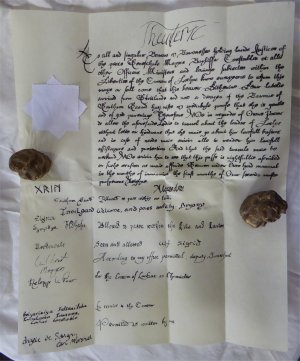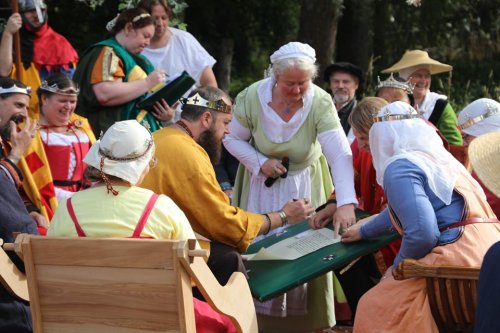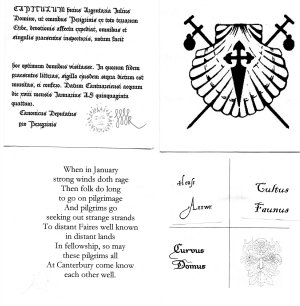 |
|
Travel Papers: Passport and Pilgrimage CredencialPilgrimage Credencial PassportFor many years I have been hunting for an extant version of a period passport or safe-conduct -- I had various text models, but no idea how they were laid out. Then I came across a reference to a plate in Shakespeare's England (Clarendon Press, 1916; pg 488-489). I had that book! Safe conducts have been around a while, but it took some time for them to be codified into law; early safe conducts were treated as part of correspondence. In 1297, William Wallace and Andrew Moray, as leaders of the Scottish army, wrote to the Mayor and citiizens of Luback and Hamburg. They thanked them for the favour shown to Scottish merchants and then said: A couple of years later, Philip IV of France wrote to his ambassadors in Rome, asking for assistance to be granted to William le Walois (Wallace) and for the Supreme Pontiff to be lobbied in the Scottish knight's favour. Henry V's administrators issued "sauf conduit", and the Safe Conducts Act was passed in 1414. They and their later passport counterparts were designed to allow people to travel without let or hindrance, though often under set conditions of time and/or location. Thus a letter of safe conduct issued in 1516 by James V for his mother Queen Margaret Tudor stated: King James, etc, to all commanders and magistrates by land and sea. Wishing to see his mother's face, and so she can provide him with solace, with the consent of John, duke of Albany, tutor and governor, [Regent] etc, and the counsel of the three estates, the king grants and permits the queen to enter Scotland with as many Scottish attendants as she wishes, and as many from other countries as Albany and the estates allow to enter. They may remain unmolested in Scotland, and the queen is to be immediately provided with and may enjoy all the rents, profits, rights etc., specified in her dowry, with no exaction extracted. And the queen and her attendants are to be unharmed and unmolested in other ways, providing the queen and her attendants do and procure nothing to the prejudice of the king, Albany or the kingdom. By the mid-1500s, passports had come into being, issued by the Privy Council but still signed by the Crown. One of the earliest mentions is in Shakespeare's Henry V St Crispin Day spech where Henry offers to release any reluctant soldiers and (slightly anachronistically) states: In a well-known and rather petty matter of pique, Elizabeth Tudor refused her cousin Mary's request for a passport in 1554 to allow her to return to Scotland from France. Mary Stuart took to the seas anyway. In 1600, one Robert Ker, Warden of the Middle Marches for Scotland, applied for a passport through England. The early passports were issued by local authorities for foreign travellers (ie not their own citizens). And they usually cited the towns the holder was permitted to pass through. The 1596 passport mentioned at the beginning of this material was for a traveler "lately come from Scotland". It notes the various places he passed through as signed by state officials and endorsed as seen and allowed to pass (eg through Cumberland, York etc). The amusing thing is that this document is actually a forgery, counterfeited by schoolmaster Ralph Bower (Landsdowne 81, No 64). He apparently forged it for a vagabond, who used the byllet to travel from Cumberland to Somerset. Typically passport applicants had to provide some reason for their travels such as going to bathes for recovery of their sycjnes or, in the case of Bower, to see his mother in Cornwall after being shipwrecked and mugged. He was granted four months to get there by reasons of his hurte and grefe; not able to goo faur in a daye; he'd claimed to have been shot with an arrow and a dart while his ship was being scavenged by wild Skottyshe and Ireshe. From the latter half of the 15th century, Italian authorities would issue bollette de sanita or bills of health for travellers. It compiled extensive details -- name, age, physical description, residence, parish, gate, destination and reason for trip. Later passports had broad coverage regarding addressees, like this one signed off by Thomas Parry in 1603 (Perez, pg 237): My Passport
I based the look of my passport on the 1596 Bower one and, after finding a decent image of it which was readable, used some of the text as a model. To all and singular Barons & Baronesses holding lands, Iusticies of the peace, Seneschals, Mayors, Bayliffes, Constables and all other Officers, Ministers and lovinge subjectes within the Liberties of the Crown of Lochac know everye one to whom this maye or sall coume that this bearer Katherine Kerr, latelie arrived from Skottlande and now a denizen of the Baronie of Southron Gaard, has iuste & credabyle proofe that she is gentl and of good parentage. Therefore We in regarde of Owre power do allow the aforesaide ladie to travel about the londes of Lochac without lette or hindrans that she maie go about hir lawful busines and in case of neede maie enioin alle to render hir lawfull assistaynce and protection. And that the said travails maie be reckon'd We enioin hir to see that this passe is rightfullie ascribed on suchs occasion as maie afforde. The document is on parchmentine in secretary hand, with a paper seal stamped with a Crown (this is not an official Lochac document so doesn't have the Royal Seal). I need to do some more experimentation with those embossed seals. A limited examination of examples online and in books indicated there was wax underneath and the seal stamped into the paper on top. I tried dampening the watercolour paper to take a better impression, but the heat of the wax pushed the mark back out. (That's why there are two pieces of paper in the seal, as I then had to attach another one on top.) I had planned to have His Majesty Theuderic sign it during some quiet time at Faire, but he was keen to do it in Court. So I duly introduced it as being necessary for me to be able to travel on pilgrimage to "repent of a merry youth". I then tracked down all the landed baronages and Kingdom officers at Faire and got them to sign, being sure that each endorsement was in a different hand. One lovely visiting Baronage were keen to sign it in their own lands, but consented to a preliminary authorisation. I'll take it to the Continent next time I'm there and see how many more places I may be permitted to be "seen and allowed".
References Pilgrimage Credencial
We'd had comments that the increasing growth of households and barriered campsites was making Canterbury Faire feeling somewhat unfriendly, so I proposed a Pilgrimage whereby people were encouraged to drop in at participating campsites to say hello, be welcomed and so forth. The Pilgrimage was for a set time during the first evening of Faire; pilgrims were encouraged to pick up an official credencial from the Green Man and then be on their way. The Pilgrimage credencial was based on the Latin version used for the Camino Santiago route (I haven't been able to find out how far it dates back): Or : I signed it with a superscrivit flourish and stamped it with a cheerful sunne in splendour. Mixed-format media like this (ie print and handwritten) dates back to the beginning of printing, with indulgences and the like being pre-printed and details filled in. (Actually prior to printing as there are examples of household documents being handled the same way in manuscript form.) The inside of the credencial consisted of a list of participating households/campsites, and a salutory poem adapted from Chaucer:
And the back page had a pilgrimage scallop, with staff and Santiago cross. Given that the incoming Baroness was Alexandra de Santiago, that seemed nicely appropriate. Around eight of the 14 identified groups chose to take part and I handed out a batch of "Welcome Pilgrims" signs to indicate that. One household was busy prepping for their Baronial investiture, so they announced a special pilgrimage hour later in the week as a welcome from the new B&B to the populace. I'm not sure it really worked -- about half-a-dozen people turned up to collect their credencials. Maybe if it was done with a pilgimage leader. Further research and tweaking may be necessary.
| ||||||||||||||||||||||||||||||||||||||||||||||||||||


